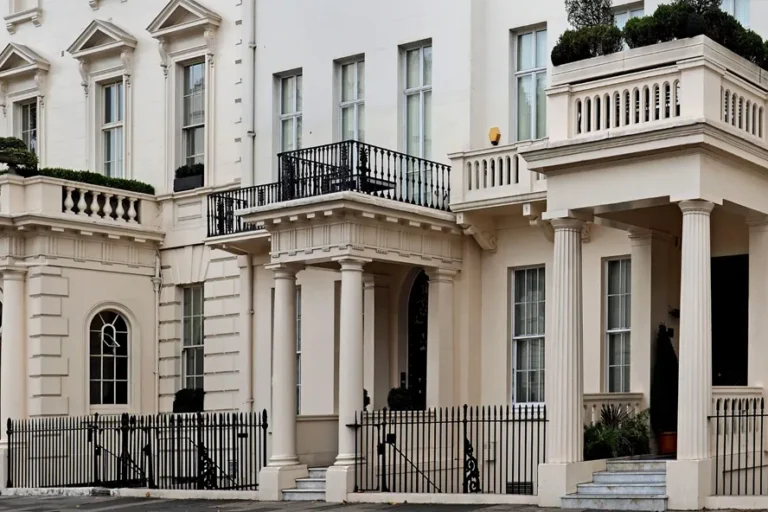We are pleased to highlight the successful completion of a lifetime mortgage on a £4.5M property in Notting Hill.
Market Insights
Opportunities and challenges for high-net-worth and ultra-high-net-worth Individuals
As we progress through 2025, the global investment environment is characterised by promise and uncertainty. High-net-worth (HNW) and ultra-high-net-worth individuals (UHNWIs) face a range of factors shaping their strategies, from political developments to economic trends.

Author
Geoff Garrett | Co-Founder & Specialist Debt Adviser
Posted
May 13, 2025
Share
Market overview
The re-election of Donald Trump as President of the United States has introduced a complex dynamic, with sweeping trade tariffs and protectionist policies casting a shadow over global markets. These measures, aimed at reshaping trade balances, have amplified uncertainty across key sectors, creating risks and opportunities for discerning investors.
The global economy, according to the International Monetary Fund (IMF), is expected to grow by approximately 3.2% in 2025. This indicates a steady pace compared to the previous year, reinforcing your statement about cautious optimism despite ongoing challenges.
For advanced economies in 2025, the US is expected to experience growth of between 1.8% (Federal reserve estimate) and 2.2% (EY projection), indicating a modest but positive outlook.
The UK and broader Europe are also expected to recover modestly, with the euro area projected to grow by 1.3% in 2025. Growth in emerging markets is anticipated to slow somewhat, with forecasts ranging from 3.7% to 4.1% for 2025. India remains a standout, with growth expected between 6.2% and 6.4%.
However, global inflationary pressures, elevated geopolitical tensions, and factors like US tariffs and currency volatility are affecting the momentum of emerging markets. Inflationary pressures remain a concern, especially for emerging markets, due to aspects such as US trade policy and global fragmentation. Geopolitical tensions, including conflicts and trade disputes, present significant challenges for both advanced and emerging economies
Inflation trends and monetary developments
risks. The IMF projects a drop to 4.2% in 2025 and 3.5% in 2026, driven by easing supply chain pressures and restrictive monetary policies.
However, surveys indicate slight upward revisions, forecasting a 4.0% global average inflation rate for 2025 due to persistent trade restrictions and energy price volatility. Advanced economies like the US and Western Europe are approaching their inflation targets more quickly, while emerging markets endure prolonged pressures, particularly in Africa (e.g., Northern Africa at 36.1%) and parts of Asia.
Monetary policy is shifting toward gradual easing. The US Federal Reserve is expected to cut rates to 3.75% by mid-2025, balancing tariff-induced inflation risks and slowing growth. The European Central Bank may reach neutral rates (1.5% – 2.5%) sooner, reflecting weaker growth in the eurozone. The Bank of England has already begun cuts, reducing rates to 4.25% in 2025, though energy costs could temporarily push UK inflation to 3.7%.Key risks include trade policy shifts (e.g., US tariffs), uneven disinflation in service sectors, and geopolitical energy disruptions. Central banks remain cautious, prioritising data-dependent approaches to avoid reigniting price pressures. Against this backdrop, HNW and UHNWIs may find 2025 a rewarding time to capitalise on opportunities in property and other tangible assets.
US trade policies and global tariff uncertainty
President Trump’s return to the White House has been marked by a renewed focus on “America First” policies, impacting global trade flows. New tariffs on goods from China, Europe, and other key markets are surging, creating ripple effects in supply chains worldwide. For international investors, these measures have heightened market volatility and raised concerns over inflationary pressures. However, they also open up niche opportunities in stabilised sectors such as technology, healthcare, and alternative energy.
The UK’s position within this shifting global dynamic could prove advantageous. As trade agreements are renegotiated under the new US administration, London continues to flourish as a global financial hub, attracting international capital from regions such as the Middle East and Asia.
Prime central London property opportunities in 2025
Prime Central London (PCL) is currently a buyer’s market, with 79% of properties selling below asking price and average discounts of 8.6%. Some areas, such as Mayfair and St James’s, are experiencing discounts as high as 13.8%, with prices still well below peak levels. Transaction volumes are rising, particularly in the £2 to £5 million segment, indicating renewed activity and greater choice for buyers[11].
Most forecasts anticipate a year of consolidation in 2025, with modest price movement. Knight Frank expects PCL prices to grow by 2% in 2025, while Savills predicts a short-term dip of around 4% before a medium-term rebound. Over the next five years, cumulative growth of about 9% to 10% is anticipated as the market absorbs recent tax and policy changes.
Key investment opportunities
Significant discounts in prestigious areas provide negotiation opportunities for buyers, particularly for “best-in-class” properties in the £5 to £10 million range. Medium-term forecasts suggest that purchasing during this period of price softness could yield strong capital gains as the market recovers.
High rental demand and limited supply continue to support yields, making buy-to-let investments in prime locations attractive, especially as mortgage rates are expected to ease. Despite tax changes (notably the end of the non-dom regime), London’s global status and safe-haven appeal continue to attract overseas buyers, particularly from the US and the Middle East. With the new tax regime now clearer, uncertainty is reduced, which may encourage both domestic and international buyers to re-enter the market.
However, higher stamp duty and the end of non-dom tax status may dampen some overseas demand. Still, the market is expected to adjust as buyers become familiar with the new rules. Price growth is likely to be muted in the near term, with stronger gains anticipated from 2026 onward as economic stability returns and interest rates fall.
Non-dom new regime from 6 April 2025
The previous remittance basis and domicile status have been abolished for tax purposes. A new residence-based system applies. Individuals who have been non-UK residents for at least 10 years can benefit from a four-year exemption (“Foreign Income and Gains” or FIG regime) when they become UK tax residents. During these four years, foreign income and gains are not taxed in the UK and can be brought into the UK without incurring a tax charge.
After the four-year period, worldwide income and gains become taxable as they arise, just like any other UK resident. For Inheritance Tax (IHT), individuals will be taxed on worldwide assets if they have been UK residents for at least 10 out of the last 20 years, with a “tail” period after leaving the UK. Transitional rules will apply, including a Temporary Repatriation Facility to allow for bringing in previously untaxed foreign income at a special rate.
Global perspective on international property investment in 2025 and beyond
The global property market is at a turning point in 2025, with signs of recovery following a period of volatility and subdued investment activity. Investors deploying capital in 2025 will likely benefit from an “early-mover advantage,” as the market cycle shifts and competition for high-quality assets intensifies. Liquidity is returning, bid-ask spreads are narrowing, and institutional investors are re-entering the market, especially in North America, where investment is forecast to grow significantly.
New supply is constrained across most commercial property sectors, particularly in the US and Europe, which is driving up competition for prime assets. Data centres, logistics, and residential sectors are especially affected by supply-demand imbalances. Data centres, energy infrastructure, and logistics are prime prospects due to the surge in AI, digitalisation, and the energy transition. Hotels, particularly at both the high and low ends, are also experiencing renewed investor interest as tourism rebounds in key markets.
North America leads in recovery, while Europe and the UK benefit from gradual rate cuts. The Asia-Pacific region shows resilience, with Japan standing out in hotel and hospitality investment. Although interest rates are generally trending downward, the pace remains uncertain, and required returns may stay elevated for a longer time in some regions. Ongoing geopolitical tensions, shifts in trade policy, and regulatory changes could disrupt recovery or alter investment strategies, particularly in Europe and the US.
Success depends on understanding local market nuances, asset quality, and sector trends instead of broad market exposure. Sustainability, energy efficiency, and green credentials are increasingly critical, influencing both demand and valuation. Investors and occupiers must stay agile, prepared to respond to shifting market conditions, supply constraints, and evolving corporate space needs.
Investment outlook for luxury assets in 2025 and beyond
Art
Digitalisation is profoundly reshaping the art market in 2025, creating significant shifts in how art is bought, sold, and appreciated. Online sales account for approximately 25% of global transactions, signalling a growing reliance on digital platforms to connect buyers and sellers. This transition to online marketplaces is making art more accessible, particularly to younger collectors who are attracted to the convenience and transparency of digital transactions. The digital space also opens up opportunities for collectors who may have previously felt excluded from the traditional gallery or auction house experience, thus democratising access to the market and fostering a new generation of art enthusiasts.

Despite ongoing economic and geopolitical uncertainties, the art market demonstrates resilience as a preferred safe haven for investors seeking to preserve their wealth. Art’s intrinsic value and its potential for long-term appreciation attract a wide range of buyers, from seasoned collectors to first-time investors. Key areas of growth are expected to include private sales and digital platforms, both of which offer unique advantages: private sales provide anonymity and exclusivity, appealing to HNW and UHNW individuals, while digital platforms facilitate quicker transactions and increase visibility for artworks. These avenues particularly focus on established artists and works with strong provenance, as buyers increasingly prioritise authenticity and investment-grade pieces in their acquisitions.
Emerging markets are also influential in broadening the global collector base. Countries in Asia, the Middle East, and Latin America are rising as significant art hubs, offering new buyers and fresh talent to the international scene. These regions bring diverse cultural perspectives to the market, driving demand for works that reflect local identities while also fostering global interconnectedness. The influx of new participants not only diversifies the market but also challenges traditional centres of the art world, forcing established players to adapt and appeal to a more global audience.
Furthermore, sustainability is becoming a defining trend in investment patterns, with collectors increasingly focusing on the environmental and ethical impact of their acquisitions. From sourcing materials to transportation and exhibition practices, sustainability is gradually shaping how art is created, marketed, and preserved. This aligns with the broader movement towards socially responsible investing, where buyers strive to align their portfolios with values that emphasise environmental and societal impact.
The convergence of these factors is driving transformation across the art world, shaping its future in ways that are redefining the meaning of ownership, access, and value. Amid rapid digitalisation and evolving collector preferences, the global art market in 2025 stands as a dynamic and adaptive ecosystem, poised for continued growth and innovation.
Jewellery
Jewellery is expected to experience robust annual growth of 4% to 6% through 2027. This steady expansion highlights the enduring appeal of jewellery as more than just an accessory; it is a “hard luxury” asset with significant cultural and financial meaning. Its dual role as a status symbol and a tangible store of value continues to set it apart in the luxury goods market.
One of the key drivers behind this growth is jewellery’s ability to convey wealth, stability, and social standing. Owning fine jewellery is not merely about personal style or aesthetics but also about showcasing affluence and success. These qualities have ensured that jewellery remains a timeless marker of prestige across cultures and generations.
Additionally, jewellery’s intrinsic value and liquidity make it an attractive option for investors. Unlike other luxury items, such as designer clothing or high-end electronics, jewellery tends to retain its worth over time. During periods of economic uncertainty, consumers often turn to jewellery as a safe haven for wealth. Gold and diamonds, in particular, are considered resilient assets, offering a level of financial security that few other luxury products can match. This trend has been especially evident during recent global disruptions, with consumers favouring hard assets over more volatile alternatives.
Furthermore, technological advancements like virtual try-ons and e-commerce platforms are enhancing accessibility and improving the shopping experience for luxury high-end jewellery. These tools enable buyers to browse, customise, and purchase luxury pieces effortlessly, breaking down traditional barriers to entry such as geography and access to exclusive boutiques. Simultaneously, new design innovations cater to modern tastes, blending timeless elegance with contemporary minimalism to attract younger demographics.
Together, these factors create a dynamic market environment for jewellery, reinforcing its strength as both a luxury product and a financial asset. By combining beauty, cultural significance, and investment potential, jewellery continues to thrive as a preferred choice for consumers worldwide, even in volatile economic climates. This blend of tradition and adaptability ensures that jewellery will remain an enduring asset class in the years to come.
Timepiece Watches
The luxury watch market, projected to reach a valuation of approximately $72 billion by the end of 2025, has become a compelling arena for both collectors and investors. With anticipated annual growth rates of 5% to 12% through 2030, this sector continues to attract attention, not only for its craftsmanship and cultural significance but also for its financial potential. The market experienced a notable correction in 2024, prompting a shift in investor priorities toward timepieces that embody enduring value and authenticity. This realignment has underscored the importance of brand integrity, scarcity, and documented provenance in decision-making for those seeking assets that hold or grow in value.
Watches from iconic brands like Rolex, Patek Philippe, and Audemars Piguet have emerged as particularly sought-after investment pieces. These brands are famed for their exceptional craftsmanship, rich heritage, and ability to retain strong resale values. Beyond their symbolic status as luxury items, they also represent solid choices for capital preservation and liquidity.
Rolex, for instance, is synonymous with reliability and universal appeal, making its models, such as the Daytona or the Submariner, both culturally iconic and financially resilient. Patek Philippe, with its emphasis on generational heritage, creates ultra-limited pieces like the Nautilus 5711, which often experiences massive appreciation in value due to their scarcity and exclusivity. Similarly, Audemars Piguet, known for its avant-garde designs like the Royal Oak, captivates collectors with its innovative legacy and limited production numbers.
The upward trajectory of the luxury watch market is driven by several factors, including rising disposable incomes among affluent buyers, the growing global interest in collectable assets, and the increasing perception of high-quality watches as symbols of status and sophistication. Additionally, the surge in interest in secondary markets and auction platforms has expanded accessibility, fuelling demand for coveted models.
Scarcity plays a critical role in this dynamic. Limited production runs, exclusive collaborations, and the sheer difficulty in acquiring certain models enhance their desirability, creating a sense of exclusivity. Brand integrity, often linked to a company’s history and commitment to excellence, further deepens the appeal, as buyers increasingly prioritise pedigree and reputation. Meanwhile, provenance acts as a vital safeguard in an investment setting, providing transparency and assurance regarding the authenticity and ownership history of a piece.
Overall, the combination of heritage, innovation, and sustained demand ensures that luxury watches remain not only timeless symbols of luxury but also valuable additions to diversified investment portfolios. For those seeking both financial returns and objects of beauty, the refined art of horology continues to endure through time.
Yachts
While global uncertainty and rising inflation are prompting cautious decision-making among investors and affluent individuals, the overall expansion of global wealth continues to fuel demand for super yachts and other luxury marine assets. This growth underscores a strong appetite for high-end, bespoke experiences that cater to the ultra-wealthy, even amid economic fluctuations.

According to The Knight Frank Wealth Report, global wealth is projected to grow by 3.1% in 2025, providing a robust financial foundation for continued investment in luxury goods, including prestigious yachts and other marine leisure products. This steady increase in wealth not only supports the market but also suggests a shift in how buyers approach these high-value purchases. While sustained wealth growth creates opportunities for manufacturers and brokers in the luxury marine industry, it also highlights a growing trend of selectivity among buyers.
Affluent consumers are expected to prioritise assets that reflect their personal values and tastes, emphasising craftsmanship, innovation, and sustainability. For the luxury marine market, this translates into a heightened demand for eco-friendly designs, advanced technologies, and customisable options that provide both exclusivity and future-proofing. Companies operating in this space must meet these shifting preferences by offering cutting-edge products that not only deliver opulence but also align with the evolving expectations of conscientious buyers.
Overall, increasing wealth and discerning purchasing habits create a unique blend of challenges and opportunities for the luxury marine sector, paving the way for sophisticated, future-focused market strategies.
Private Aircraft
Private aircraft often reflect trends similar to those seen with yachts, as both represent luxury assets closely tied to the ebb and flow of global wealth and economic confidence. These high-priced items serve as symbols of affluence, with their demand rising and falling in sync with the financial climate. During times of economic stability or growth, HNW and UHNW individuals tend to invest more freely in such assets, appreciating the exclusivity, convenience, and prestige they offer.

Private aircraft, much like yachts, are not merely tools for travel or leisure. They serve as status symbols that signify success while providing unmatched privacy and control over personal schedules. With private jets, owners bypass the constraints of commercial travel, such as security checks, delays, and the loss of anonymity. Similarly, yachts offer an exclusive way to relax or entertain while escaping crowded destinations. Both embody a lifestyle of autonomy and privilege that appeals to the world’s wealthiest individuals.
However, when economic uncertainty looms, spending habits among this elite group can shift. While HNW and UHNW individuals are less affected by short-term economic fluctuations than the general population, there is often a heightened sense of caution. Discretion comes into play, with buyers opting for more strategic or efficient purchases. For instance, potential jet buyers might explore fractional ownership programs or pre-owned aircraft, maintaining the benefits of private aviation without the full financial commitment. Similarly, yacht buyers may prioritise refitting existing vessels over commissioning entirely new builds.
Ultimately, private aircraft and yachts maintain their allure as the epitome of luxury, privacy, and convenience. Even during volatile periods, demand endures, albeit in a more mindful form, as these assets continue to play a key role in the lifestyles of the ultra-wealthy.
Please note: This article is intended for informational purposes only and does not constitute financial advice. The information contained herein is based on market conditions and opinions at the time of publication and is subject to change without notice. This article may contain references to or summaries of market research reports or analyses prepared by external providers. Henry Dannell does not endorse or adopt the views expressed in any such third-party reports. We recommend that you review the original research reports before making any decisions based on their content. Please also note: a mortgage is secured against your home or property. Your home or property may be repossessed if you do not keep up repayments on your mortgage or any other debt secured on it.


